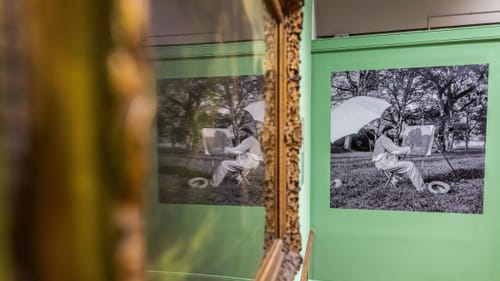Stay in the Loop
BSR publishes on a weekly schedule, with an email newsletter every Wednesday and Thursday morning. There’s no paywall, and subscribing is always free.
One painting, many stories
UPenn’s Arthur Ross Gallery presents At the Source: A Courbet Landscape Rediscovered

A small landscape by French painter Gustave Courbet (1819-1877) is the star of At the Source: A Courbet Landscape Rediscovered. As the starting point for studies and stories, it shines.
A public figure and leader of the Realist arts movement, Courbet lived a life of contrasts. His paintings were both reviled and celebrated. At the height of his popularity, his politics landed him in jail. His portraits, nudes, and landscapes reflect a quest to see the essence of his subjects, to describe what is hidden. One of his landscapes was itself hidden for 50 years or a century; no one knows. Once part of a glittering collection in a Paris mansion, the painting came by bequest to the University of Pennsylvania in 1912. At some point it was put in a box and forgotten in the basement of the Thomas W. Evans Museum and Dental Institute.
Building renovation workers noticed the box in 2016; by then, Courbet’s unframed painting was discolored to a uniform brownish-gray. However, UPenn curator and Arthur Ross Gallery executive director Lynn Marsden-Atlass noticed part of a signature: “G. Co.” The canvas was cleaned and restored, then analyzed and authenticated. At the Source: A Courbet Landscape Rediscovered, up through Sunday, May 28, at UPenn’s Arthur Ross Gallery and amplified by talks and a podcast episode about authenticating the painting, is a celebration of the picture.
An outrageous artist
Curated by Marsden-Atlass and André Dombrowski, professor of 19th-century European art at UPenn, the show is composed of seven paintings (including three by Courbet) and books, postcards, and papers that illuminate the rediscovered picture’s context. It’s a perfectly lovely painting, but the history around it is arguably more interesting. Courbet and his art were outrageous in his day.
In his landscapes, Courbet used the texture of paint to delineate forms and build up palpably rocky surfaces, often applied with a palette knife instead of a brush. He rejected then-popular idealized visions of workers and country life, and his realistic portrayals of average people were considered shocking. Earthy and grim, The Burial at Ornan (1849-50) shows a funeral in his hometown, attended by his family and friends.
Working on the outside
UPenn’s La Source du Lison/The Source of the Lison (1864) is a dark oil painting on a smallish canvas, mostly executed in browns, grays, and greens. Courbet deliberately excludes the skyline: the dark cave is his central figure, framed by pale overhanging rocks, some greenery, and a waterfall cascading into a blue-green pool. The picture is best enjoyed close-up, a tactic that helps reduce the visual distraction of its shiny new frame (a period reproduction).
Among the Courbet works lent to the show is another painting of the same Lison River scene. Privately owned and usually displayed at the Minnesota Marine Art Museum, it was also created in 1864. It’s larger than UPenn’s painting, and the colors are more autumnal. Courbet uses its vertical composition to hone in on the waterfall and add height to the rocks above. Again, no glimpse of sky enlarges the scene: attention is placed on the dark, hidden birthplace of the river.

A photograph of Courbet working on a painting outdoors, made in 1864, is also reproduced for the exhibit. Until American artist John G. Rand invented the paint tube in 1841, it wasn’t easy to carry oil paints around. Ever among the vanguard, Courbet often completed his landscapes outdoors, while most artists kept to the tradition of sketching outside but finishing paintings in their studios.
Eventful lives
His art was revolutionary, and so were the times. Courbet lived through a couple of actual revolutions, a war, and five political regimes. He was a prominent member of the Paris Commune, an uprising begun in March 1871 that was brutally crushed in May. Courbet was lucky to be jailed for only six months, but later all of his paintings and assets were seized. He fled to Switzerland where he died of liver failure at the age of 58.
The former owner of The Source of the Lison had an eventful life, too. Thomas W. Evans, a Philadelphia dentist, moved to Paris in 1847, delighting patients like Napoleon III with his skill and pioneering use of nitrous oxide. Evans soon became the go-to dentist of Europe’s rich and royal. He and his wife built a mansion, and Édouard Manet and Courbet were among the artists whose pictures hung on their walls. Most of Evans’s estate was left to the founding of a museum and dental school in Philadelphia. After years of legal argle-bargle, UPenn’s Thomas W. Evans Museum and Dental Institute was built in 1915, and Evans’s art collection was displayed there. It’s unclear whether the Courbet was ever on view.
What, When, Where
At the Source: A Courbet Landscape Rediscovered. Through May 28, 2023, at Arthur Ross Gallery, University of Pennsylvania Fisher Fine Arts Building, 220 South 34th Street, Philadelphia. (215) 898-2083 or arthurrossgallery.org.
Accessibility
The accessible entrance to Arthur Ross Gallery and Fisher Fine Arts Library is through the Duhring Wing on the building’s south side opposite Irvine Auditorium. For access, call (215) 898-2083 in advance or the guard's desk at (215) 898-1479 on arrival.
Sign up for our newsletter
All of the week's new articles, all in one place. Sign up for the free weekly BSR newsletters, and don't miss a conversation.

 Emily Schilling
Emily Schilling